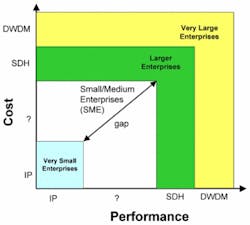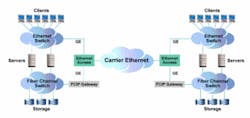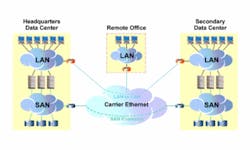The case for SAN extension over Ethernet
Leveraging the scalability, ease of management, and lower cost points of Ethernet, SAN extension over Ethernet gives service providers a powerful tool for pursuing the burgeoning SAN extension services market.
By Umesh Kukreja, Atrica Inc.
Driven by the growing recognition of data's vulnerability to attack and new legislation that demands greater accountability, storage area networks (SANs) have become big business in the large enterprise market. And while small- to medium-sized enterprises (SMEs) share similar concerns, the high cost of wide-area SAN connection has kept SANs out of reach for most of these companies, effectively putting the brakes on what could be a major market opportunity for today's service providers.
Fortunately, the combination of two state-of-the-art networking technologies is opening up this market, bringing cost-effective SAN extension services to SMEs worldwide: SAN extension over Ethernet.
The SAN extension opportunity
SANs interconnect the hosts (or servers) to storage devices, enabling access to mission-critical data by anyone at any time. They enable storage devices to connect with each other, making operations such as data backup and synchronization effortless. SANs also allow the virtualization of storage devices, which enables storage devices to function as one single, logical disk regardless of the physical location of the network.
The increased interest in SANs is the result of enterprises' growing reliance on electronic data for day-to-day business management. In order to manage the explosive growth of data warehouses and to reduce the overall cost of IT infrastructure, IT departments have built data centers for centralized data procurement, storage, and manipulation, and they are consolidating sophisticated IT equipment in a few data center locations.
This interconnection of data centers across the wide area network is a key consideration in enterprise SAN strategies. SAN extension provides an efficient method for service providers and enterprises of all sizes to interconnect their data centers for business continuity, disaster recovery, data mirroring, content distribution, and IT infrastructure consolidation.
Due to the complex nature of the technology and the limited availability of financial and IT resources, however, SANs and SAN extension networks to date primarily have been private networks run by large enterprises. Typically, service providers have provided the dark fiber to connect private networks owned and managed by very large enterprises. For the enterprises, this is a costly, resource-consuming option. And from a service provider perspective, this is a low-value commodity business.
In today's business climate, an increasing number of SMEs are becoming concerned about disaster recovery, data backup, and business continuity strategies, but they lack the technical and financial resources to build and manage their own metro-wide data centers. SAN extension over Ethernet provides a new managed service opportunity for service providers with a wide area footprint in a metro area, and this service should be of interest to both large enterprise and the huge market of SME customers.
SAN extension architectures
Current options for SAN Extension network architectures include:
- DWDM-based SAN extension: Traditional enterprise-wide SANs have been primarily built by very large enterprises leveraging their private DWDM networks and leased dark fiber to connect the various data centers. This strategy is prohibitively expensive for SMEs.
- SONET/SDH-based SAN extension: SONET/SDH-based SAN extension leverages the Generic Framing Procedures (GFP) standard to encapsulate the Fibre Channel traffic transparently throughout the SONET/SDH network. While technically feasible, the high-bandwidth requirements for SANs (1G, 2G, or fractional 10G) are not readily available in a SONET/SDH access network. And when they are available, the costs are often prohibitive.
- IP-based SAN extension: Some very small enterprises have been able to leverage the connectionless Internet environment for storage backup and recovery applications. For very small enterprises with limited data that can tolerate the nondeterministic nature of the public Internet, this is a viable entry-level SAN strategy. However, the need for higher bandwidth, security concerns about the public Internet, and the desire for real-time backup and recovery continue to limit the growth of IP-based SAN extension networks.
The following diagram illustrates a key revenue opportunity in the SAN Extension market: enterprises that have higher bandwidth, synchronization, reliability, and scalability requirements than IP-based options can support. For these enterprises, a combination of Carrier Ethernet technology and a Fibre Channel gateway can be less expensive than deploying DWDM- or SONET/SDH-based architectures.
From a service provider perspective, SAN extension can be positioned as a premium service, expanding an Ethernet service portfolio that may already consist of an E-LAN-based LAN interconnect service offering, an E-Line based point-to-point private line service offering, and an Ethernet-based Internet access service (based on an E-Line service).
Carrier Ethernet-based SAN extension
Carrier Ethernet is differentiated from traditional enterprise-class Ethernet by its ability to support:
- Guaranteed, end-to-end service level agreements (SLAs), thanks to its ability to support committed information rate (CIR) for guaranteed, mission-critical applications, and excess information rate (EIR) for best-effort traffic. The ability to support real-time synchronized traffic with very low delay is critical for SAN extension services.
- 50-msec protection for a highly resilient WAN service connection. The resiliency must be independent of the classical spanning tree-based protection offered by enterprise-class Ethernet platforms.
- Scalability beyond the VLAN limitation of traditional Ethernet switches.
- Carrier-class operations, administration, and maintenance (OAM) with very simple service provisioning and management.
A Carrier Ethernet-based SAN extension service brings together a full set of features and functionality that can make a very attractive managed service offering not only for SMEs, but also for larger enterprises interested in migrating from their private network to a managed SAN extension service. Some of the key features of such a service include:
- Guaranteed bandwidth with no packet loss and very low delay and jitter. This feature would use traffic engineering to reserve bandwidth between two data centers specifically for a SAN extension service customer.
- High levels of security, thanks to connection-oriented circuit provisioning.
- High availability, thanks to 50-msec failover capabilities, should any link failures occur.
- Long distances, very similar to DWDM-based networks.
- Cost-effective pricing to meet SME budgets for disaster recovery and data backup.
More importantly, provisioned SAN extension service bandwidths can scale as enterprise requirements dictate, with very minimal moves, adds, and changes.
Case study
For example, one of the industry's first SAN extension-over-Ethernet service offerings is Orange Business Services' i-SAN service. Offered as a value-added service with Orange Business Services' MAN Ethernet and Datacenter services, i-SAN provides a functional and affordable SAN extension alternative to businesses of all sizes. In terms of operation, supervision, and management, it is completely integrated into Orange Business Services' network via Fibre Channel interfaces delivered on an innovative SAN gateway.
As an inter-MAN service, i-SAN is offered across Orange Business Services' MAN Ethernet network in France with no distance limitations. With i-SAN, SMEs and large enterprises benefit from the choice of multiple topologies (e.g., point to point, multipoint to multipoint, or any to any), plus rapid site additions/alterations or on-demand bandwidth provisioning. Because i-SAN bundles an end-to-end MAN Ethernet service with the Fibre Channel gateway, SMEs do not have to worry about the end-to-end engineering of the network.
Based on Carrier Ethernet's five service attributes—scalability, reliability, quality of service, standardized services, and service management—i-SAN offers exceptional performance, reliability, and ease of use, plus the cost benefits of its Ethernet technology. The service is compliant with Metro Ethernet Forum (MEF) standards such as MEF-9, and the SAN gateways integrated by Orange are certified from major storage vendors, including EMC2, IBM, and HP.
As service providers seek ways to stand out from an escalating array of competitors, the ability to deliver the value-added services their enterprise customers want most is critical. With worldwide Ethernet services revenue expected to jump 280% between 2005 and 2009 (from $5.9 billion to $22.5 billion, according to Infonetics Research), it is increasingly clear that today's enterprises want the scalability, flexibility, and cost points that Carrier Ethernet services offer.
Savvy service providers will look at the popularity of Carrier Ethernet among their enterprise customers, compare it to the dearth of SAN services for SMEs, and make the connection that SAN extension over Ethernet is a huge potential market opportunity.
Umesh Kukrejais director of product marketing for Atrica Inc., The Carrier Ethernet Company (www.atrica.com). He can be reached at [email protected].



